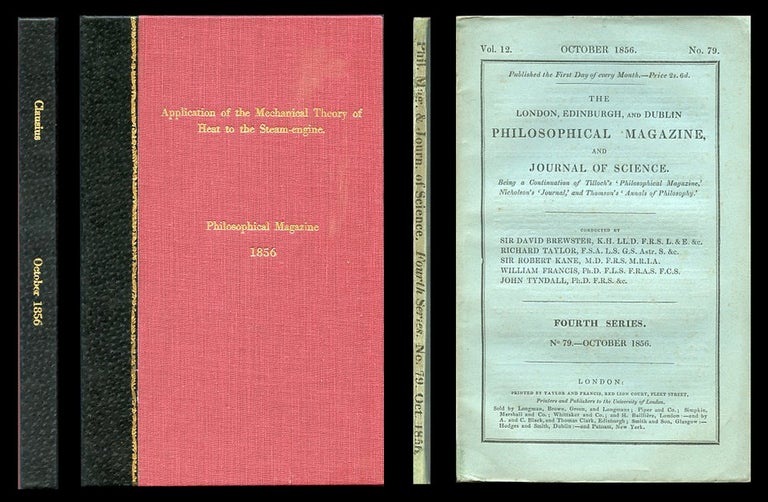On the Application of the Mechanical Theory of Heat to the Steam-engine in The London, Edinburgh, and Dublin Philosophical Magazine and Journal of Science 12 No. 79 pp. 241–265, October 1856
London: Taylor and Francis. 1st Edition. 1856 FIRST EDITION IN ENGLISH & IN ORIGINAL WRAPS OF THE PAPER IN WHICH CLAUSIUS FULLY PRESENTS HIS MILESTONE APPLICATION OF THE SECOND LAW OF THERMODYNAMICS, namely, that "Heat can never pass from a colder to a warmer body without some other change, connected therewith, occurring at the same time" (Schweller, Maxwell’s Demon, 31).
Clausius first published this work in 1854 under the title “Über die Anwendung der mechanischen Wärmetheorie auf die Dampfmaschine” [and we offer that separately]. In 1856, this paper was also published in the American Journal of Science and Arts, however the The London, Edinburgh, and Dublin Philosophical Magazine and Journal of Science publication offered here is widely cited as the first in English.
In his 1850 paper, the first on this subject, the German physicist and mathematician Rudolf Clausius (1822-1888) defined the relationship between work and heat and introduces the concept of "energy of a body" (equivalent to temperature), thus stating the ideas behind the first and second law of thermodynamics. The 1854 paper was the second of his works; and again, in 1856 it was published here in English.
In this paper, Clausius first develops the concepts of interior work, i.e. "those which the atoms of the body exert upon each other," and exterior work, i.e. "those which arise from foreign influences which the body may be exposed", which may act on a working body of fluid or gas, typically functioning to work a piston. He then discusses the three types of heat by which Q may be divided: 1. heat employed in increasing the heat actually existing in the body; 2. heat employed in producing the interior work; 3. heat employed in producing the exterior work. Building on this logic, and following his mathematical presentation of the first fundamental theorem, Clausius then presents us with the first-ever mathematical formulation of entropy. The third paper, published in 1865, invents and first uses the word ‘entropy. Item #839
CONDITION & DETAILS: London: Taylor and Francis., Volume 12, No. 79. October 1856. 4to (9 x 5.5 inches; 225 x 140mm). Complete. Near fine condition in every way; original printed wrappers.
Price: $575.00

